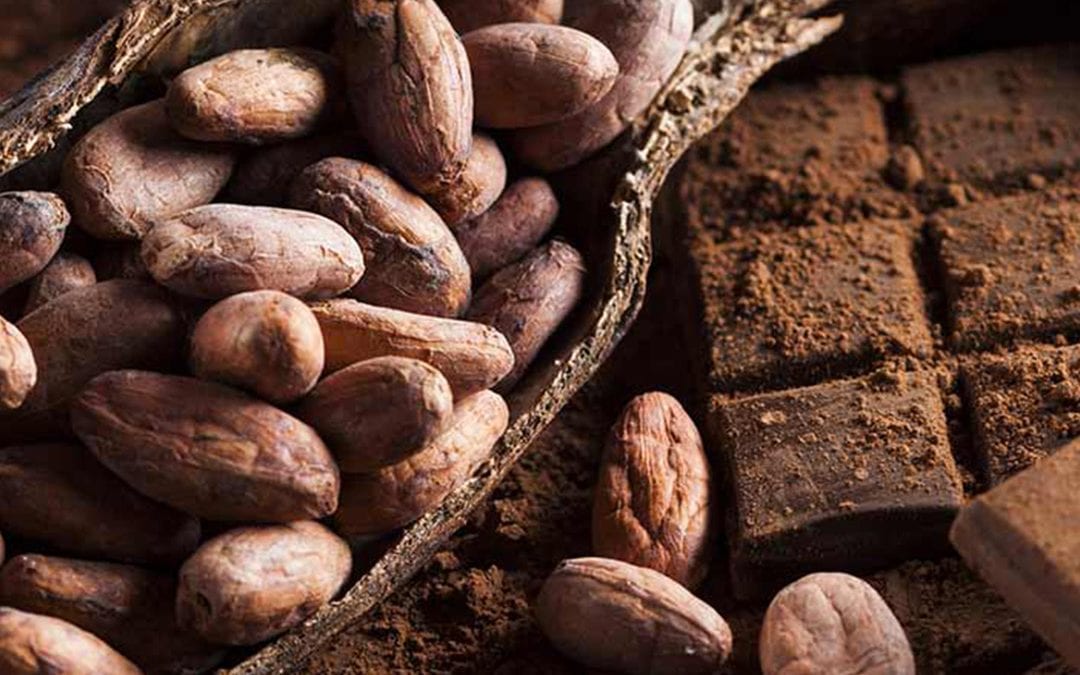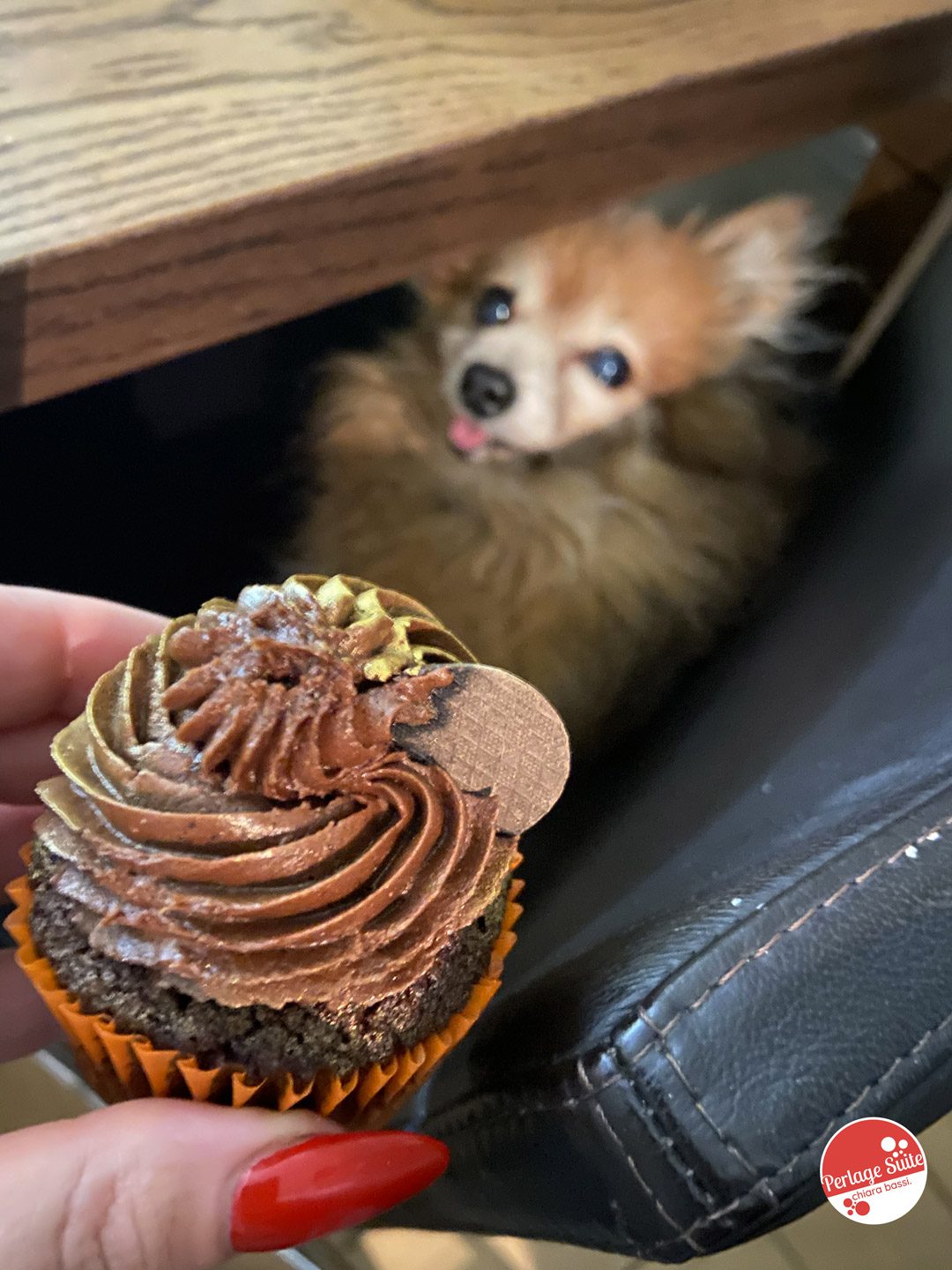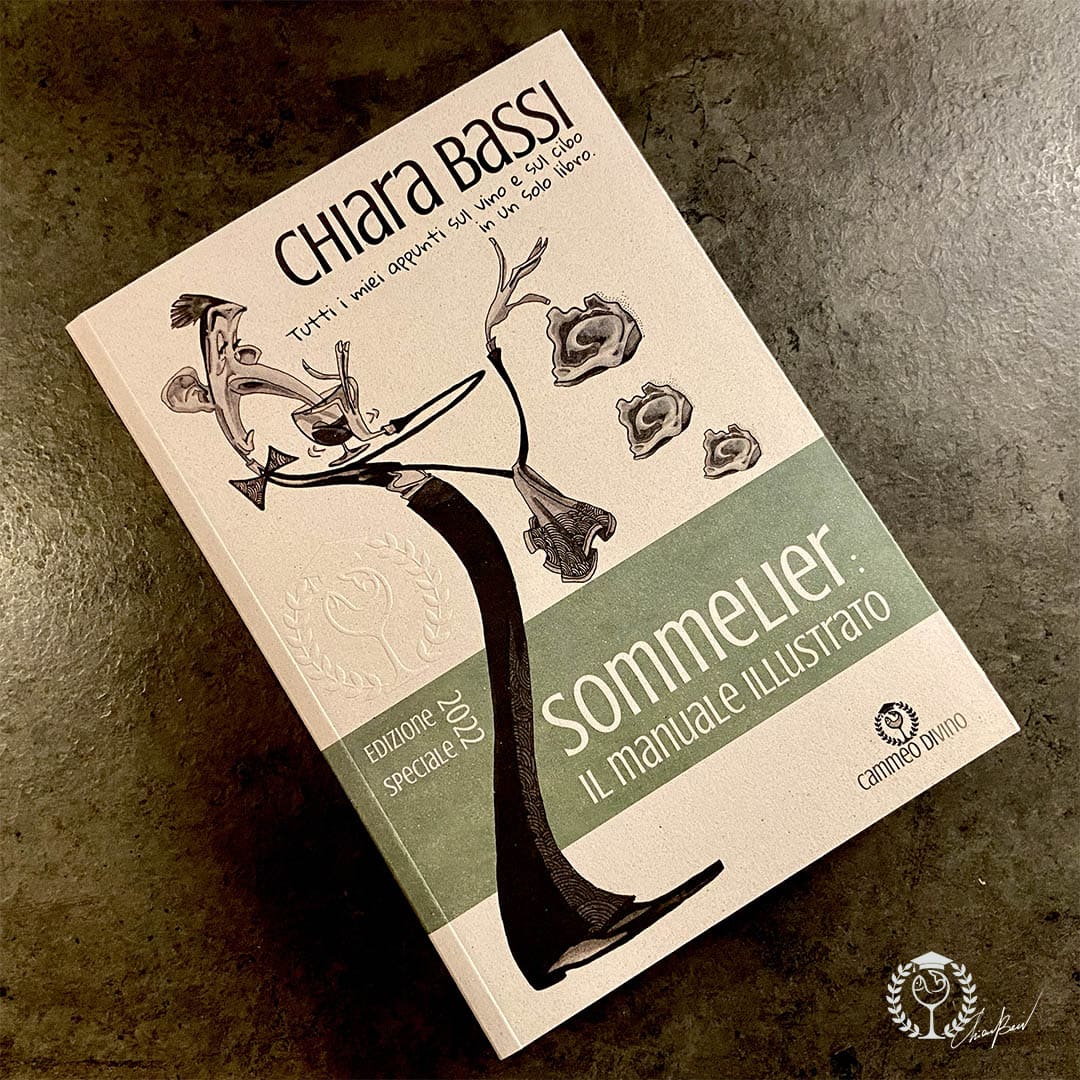For the examination of Ecology and Sustainabilitywhere I got a very good 30 on 31 March, I prepared a paper dedicated to the cocoa and the pairing with wine, vermouth or distillate. This paper aims to analyse cocoa from its history to its spread, from its effects to its production up to one of its products par excellence: the chocolate.
1. Cacao: a very long history
1.1 Origins: Maja and Aztecs
Historical reconstructions have placed the Maya as the first discoverers and cultivators of the cocoa plant around 1000 BC. According to Aztec legend, this precious plant was given by the god Quetzalcoatl to relieve human beings from fatigue. For the Aztecs it was a luxury good as the plant did not grow in their territories and had to be imported. This provides further confirmation of how the properties of cocoa and its effects on men were partly known fin by these ancient peoples.
The seeds were at the same time a symbol of prosperity in religious rituals, a medicine capable of healing illnesses of the mind and body, and the basis of the monetary system. With 3 cocoa seeds one could buy a turkey egg and with 100 seeds a canoe or a cotton cloak. The seeds were so valuable that they were often contraffacts by filling empty shells with mud. The consumption of cocoa was a prerogative of the upper classes (nobles, warriors and priests), and was one of the cornerstones of Aztec cuisine.
Initially, cocoa was called kakawa, a word of Proto-American origin that was replaced by Amygdalae pecuniariae (money almond) and infifrom the scientific termfico 'theobroma cacao' (food of the gods) coined by Carlo Linneo in the 18th century. This name was chosen precisely because of the many properties attributed to cacao fin by the ancient peoples of Central America.
1.2 The arrival of cocoa in the old continent
Cocoa arrived in Europe after the discovery of America, around 1500. It is said that the first to taste it was Christopher Columbus himself after receiving it as a gift off the coast of Honduras in 1502. He brought it as a gift to Ferdinand and Isabella of Spain, but they all snubbed this food probably because it was too bitter and therefore not suited to the tastes of the time.
It was not until 1528 with Hernàn Cortés that there was a moreffuse of cocoa in Europe when he brought some cocoa beans to Spain as a gift to Charles V.
The earliest written sources, however, only date back to 1544 when a representation of Mayan nobles visited Philip of Spain bringing many gifts from the New World, including a dark, thick drink called xocoatl made from cocoa beans. The drink was only a success after the addition of sugar and spices, including cinnamon and vanilla. In 1585, the transoceanic cocoa trade began, from Veracruz to Seville.
1.3 The Italian contribution
Chocolate, while remaining exclusive to Spain throughout the 1500s, landed in Modica, Sicily, then a Spanish protectorate. Here was imported the Aztec way of producing solid chocolate called xocoatl, which was obtained by grinding cocoa beans on a stone called metate. Hence the famous Modica chocolate was born.
Production really Italian chocolate began at the dawn of the 1600s in Florence and Venice, then called the city of confectionery itself and a rich theatre of delicacies and invigorating drinks. In 1678 Antonio Ari obtained permission from the Savoys to sell chocolate as a 'drink'. In 1802 the Genoese Bozelli built a machine to rafficocoa paste. Francois-Luis Cailler trained at the Turin School of Chocolate and in 1819 founded the first Swiss chocolate factory in Vevey. In 1865 in Turin, Caffarel mixes cocoa and hazelnuts to produce gianduja chocolate.
2. The cocoa plant
Cocoa - Theobroma (which meansfica 'food of the gods') - is a plant belonging to the Sterculiaceae family native to South America. This evergreen tree can reach a height of up to 10 metres. The leaves oval are connected to a petiole that has an articulation that can be oriented according to light intensity. I figold, which may be white, green or pink, are grouped in clusters that sprout either on the trunk or on adult branches.
The fruit It has an elongated shape and is yellow-green in colour, turning brown when ripe. It can weigh from 300g to 1 kg and contain fito 40 seeds (fava beans) dipped in a kind of clear jelly rich in sugar. I seeds are oval and flat, almond-shaped and purple-brown in colour.
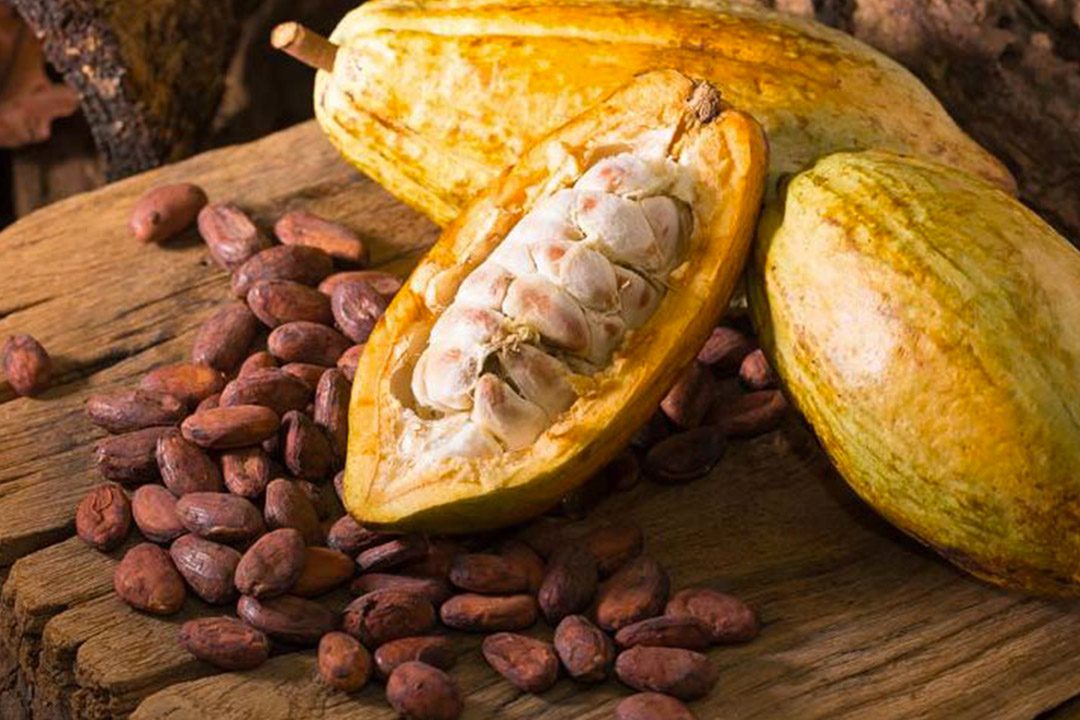
3. The cultivation and spread of the cocoa plant
The cultivation of cocoa is very expensive, starting with the high expenses for a plant that only becomes productive from the fifth year. The fruitfication, which continues throughout the year, lasts about thirty years and each tree produces an average of 1-2 kg of dry seeds.
3.1 The spread of cocoa around the world
Cocoa is cultivated between the 20th parallel north and the 20th parallel south. In particular, it is cultivated in Central and South America, Asia and Africa. In total, just under 70,000 square kilometres of cocoa are cultivated worldwide.
The finest American cocoa is cultivated in Mexico, Brazil, Colombia, Ecuador and Venezuela. The finest Asian cocoa is cultivated in Sri Lanka and Indonesia. The finest African cocoa is cultivated in Ghana, Cameroon, Nigeria, Ivory Coast and Madagascar.
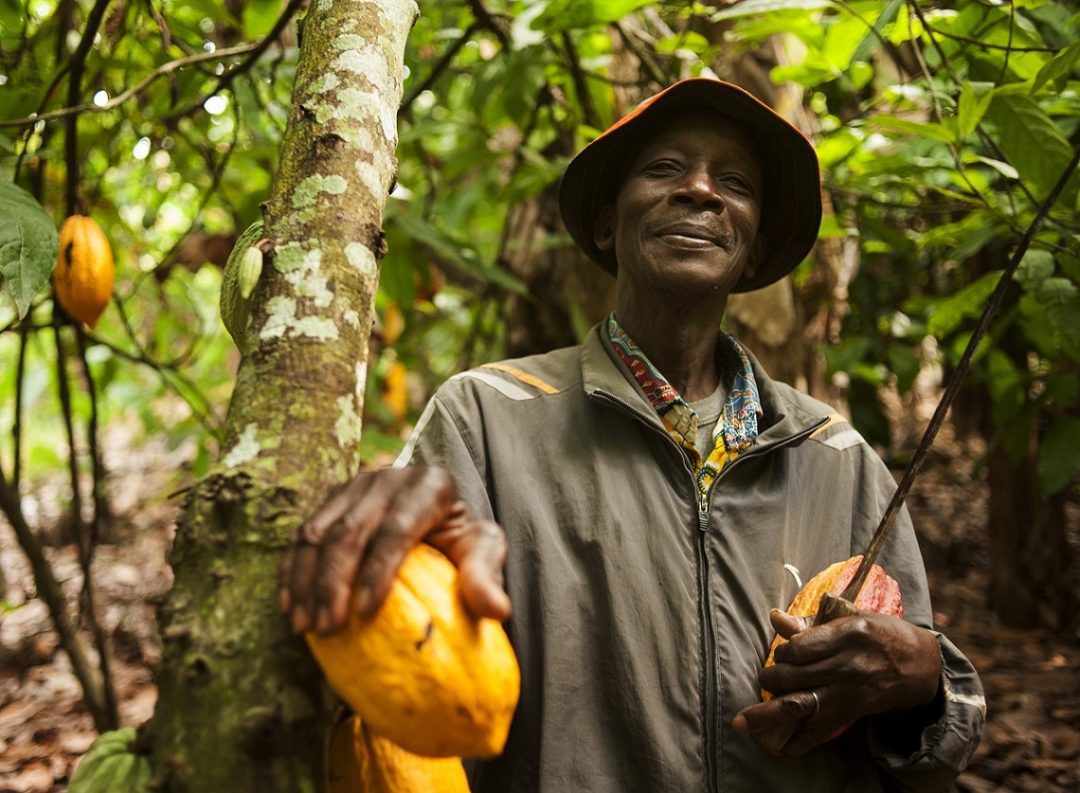
3.2 The spread of cocoa in Italy
Cocoa cannot be cultivated in Italy without being placed in a tropical greenhouse with a warm-humid climate. To create a tropical greenhouse suitable for cocoa cultivation, a temperature of around 25°C with a very high humidity of at least 70% is required.
The temperature must never fall below 18°C in order not to send thefference the fruits.
The light must be intense, but indirect. As trees are between 5 and 10 metres high in the wild, they are sheltered by taller ones. To encourage fruitfia light spectrum of between 2,700 and 3,500K can be used, while a light spectrum of 6,500K is recommended to promote the robustness of plant parts (are aquariumfithe and orchidfithe).
The cocoa plant needs abundant and regular watering, daily if possible. Even with these measures, it is almost impossible to bring the plant to fruit.fication.
4. The classification of cocoa
There are about 1300 types of cocoa classesfibut there is no class.fiuniversal designation as is the case, for example, for grape varieties in the wine world; on the contrary, each country has always adopted its own classfication. Today, major efforts are being made to standardise all the various catalogues to create a single system.
The classficocoa has always been this:
- CACAO CRIOLE = 'Indigenous', is native to Mexico. It has round white seeds that give a powdery fivery aromatic and not very bitter. It is delicate and sensitive to the weather and not very productive. It is very valuable (about 10% of world production, only to produce high quality chocolates).
- CACAO FORASTERO = 'Foreigner', is native to West Africa and Brazil. It has flat violet seeds that give a powder with a strong, sour and bitter aroma. Being robust and highly productive, it is very widespread (about 80% of world production).
- TRIUNE COCOA = 'Crossbreed', it originates from Sri Lanka and Indonesia. It is a middle ground between the previous two, with an aroma fiand a taste of cocoa butter.
Then in 2008, Venezuelan geneticist Juan C. Motamayor published 'Geographic and genetic population offferentiation of the Amazonian chocolate tree' and everything changed. In this book, starting with a very accurate genetic analysis, it was established how cacao originated in Peru in the fiume Marañón and how it has diffuse in South America through the fiumi from the Amazon. From here, Motamayor mapped the cocoa gene families and proposed a new classfielaborated on the basis of biodiversity divided into 10 main varieties from which the current cultivars are derived:
- AMELONADO
- CONTAMANA
- CRIOLLO
- CURARAY
- GUIANA
- IQUITOS
- MARAÑON-
- MARAÑON -
- NACIONAL -
- NANAY
- PURÚS
5. Cocoa production
- COLLECTION = Cabossa is the fruit of the cacao tree. This large berry (it is on average about 25 cm long, has a diameter of about 10 cm and weighs about half a kilogram) with its elongated shape has a wrinkled skin (green when unripe, orange when ripe) as hard as leather, is attached to the branches with a stalk and contains, hidden in a white pulp, about 40 cocoa beans.
- FERMENTATION OF BROAD BEANS = Pulp and seeds are fermented 3-7 days at a temperature of approximately 45°C. During fermentation, the pulp dissolves completely and is removed. Fermentation inactivates the seed, which is no longer in danger of sprouting. At this stage, all unpleasant flavours and acetic acid are eliminated and aroma precursors are created.
- DRYING = This stops fermentation and reduces the moisture content. The water changes from 60% to 6% and the colour turns dark brown. There are two types of drying: A. In the sun = Slow drying that lasts between 15 and 20 days and from which a superior quality cocoa is obtained. During this phase, the beans must be protected from both moisture (which would produce mould) and rain. The cocoa beans that spoil form cocoa butter used in cosmetics. B. Artificial = Rapid drying lasting less than 7 days and resulting in a lower quality cocoa.
- SORTING AND CLEANING = It is done manually by sliding the broad beans onto a vibrating table. Any fava beans with an abnormality are removed.
- TORREFAZIONE = This phase lasts between 60 and 120 minutes. with hot air, at a temperature between 115°C and 135°C. This is the key phase in which the best aromas are formed. This phase improves the grindability, makes the shells easy to remove and achieves bacterial safety.
- BREAKING THE BROAD BEANS AND REMOVING THE SHELLS = The beans are broken by heat at a temperature of 60-80°C and the shells separated from the grain.
- DRYING ALMONDS
- GRINDING = During this phase, the beans melt into a fluid paste. This is because the bean is composed of between 50 and 60% cocoa butter, which, when heated by mechanical action, fluidises and forms the cocoa paste.
- MIXING = Depending on the type of chocolate, the cocoa paste is mixed with: Dark chocolate (consisting of cocoa powder, cocoa butter, sugar and vanilla); Milk chocolate (consisting of cocoa powder, cocoa butter, sugar, skimmed or powdered milk, vanilla); White chocolate (consisting of cocoa butter, sugar, skimmed or powdered milk, vanilla).
- REFINING OR CONCHING = the mixture is mixed in baskets/kneaders for a very long time at a controlled temperature between 45°C and 75°C. The lower the temperature the better! The temperature must be just high enough to keep the mixture fluid. At this stage the aim is to break up the lumps of ingredients to a size imperceptible to the tongue and oxidise the tannins. The higher the quality of the chocolate, the longer the conching takes, at least 7 to 10 days, and the chocolate becomes plastic.
- TEMPERATURE = Cocoa butter tends to crystallise in a polymorphous and irregular manner, so the melt must be cooled as slowly as possible to allow it to crystallise properly (the chocolate must break down but also melt). The chocolate must be brought from 45°C to 27°C, then heated to 31°C for dark chocolate and 29°C for milk chocolate.
- MODELLING = the chocolate is poured into moulds that are kept in slight vibration to prevent the formation of air bubbles
- PACKAGING
The chocolate must be shiny, without spots, it must melt quickly and have an almost imperceptible sandiness. In the mouth it must enter sweet, but sweetness must be immediately succeeded by acidity and then a bitter tendency.
6. The effects of cocoa
Cocoa contains theobromine (vasodilator and cardiotonic alkaloid), caffeina (an alkaloid that improves concentration, excitability, reflthem and also has an analgesic function), the teofillina (an alkaloid also used in the treatment of respiratory diseases), phenylethylamine (an alkaloid and neurotransmitter believed to be responsible for falling in love and also called the 'hormone of happiness') anandamide (derived from the Sanskrit 'ananda' meaningfibliss and is an endocannabinoid neurotransmitter capable of influres our mood by calming and relaxing us) which are nerve substances that stimulate the nervous system, promote attention and concentration and limit fatigue. I love chocolate and am absolutely addicted to it.
7. The uses of cocoa
Cocoa is used for food purposes. The husk, which results from roasting cocoa in the chocolate-making process, is used to produce mulch or as a slow-release organic fertiliser. It also drains the soil and is a pesticide biocide that keeps slugs away.
8. Cocoa For chocolate production: Types of chocolate and combinations
- FLAVOURED CHOCOLATE = Vanilla, chilli, cinnamon, caffis, orange peel, mint or filled with liqueur... these are just some of the flavours of the chocolates and pralines that enchant us with their bitterness, sweetness, aromaticity and fatness... for me the ideal combination is the Vermouth.
- WHITE CHOCOLATE = Glossy ivory in colour, sweet and buttery, with an intense vanilla aroma. Not having cocoa mass among its ingredients, it does not have the typical bitter tendency of chocolate. It must contain at least 20% cocoa butter and at least 14% milk, sugar (max 55%) and vanilla. It is not suitable for pairing with wine, but if we 'must' try a vin santo or a moscadello di Montalcino.
- MILK CHOCOLATE = It is more or less light brown in colour. Intense and persistent aroma, with a distinct caramel and cocoa taste. On the palate it has good meltability, a 'soft' and buttery flavour, a perceptible amount of fat and a crunchy structure. The ideal accompaniment is a passito wine such as South Tyrolean Moscato Rosa or Recioto della Valpolicella.
- GIANDUJA CHOCOLATE = Hazelnut gives it aromaticity, roundness and mellowness and blends divinely with the chocolate flavour. Gianduia must contain at least 32% cocoa solids and 20 to 40% hazelnuts. A symbol of Turin, I also love it in the cremino version. Try pairing it with a Young Marsala.
- DARK OR BITTER CHOCOLATE = More or less dark brown in colour. As for pairing, here we enter the territory of spirits.
There are also other types of chocolate:
- MI-DOUX CHOCOLATE = One part dark chocolate and one part milk chocolate form this shiny brown chocolate with an intense and persistent scent of liquorice and caffè. It is crispy and has a melting interior.
- CHOCOLATE SURFIN = It has a deep, glossy brown colour and is characterised by an intense, strong and broad aroma with notes of roasted cocoa, liquorice and tobacco. Sweet and crisp, it slowly melts with the warmth of the mouth. Medium note of very persistent bitterness. Perfect in combination with the Agricultural Rum.
- EXTRA BITTER CHOCOLATE = It is dark brown in colour and very shiny. It has a fragrant, aromatic, very intense and persistent aroma. The nose has notes of caffis and roasted barley with a bitter and sweet taste at the same time. Perfect in combination with the Cognac.
- RAW CHOCOLATE = It is made from dried but not roasted cocoa beans and is kept below 42 °C at all stages of production. The bacterial load is reduced by insufflvapour action. It has a clean, mild, sour aroma and a wetter consistency. Avoid high temperatures sigfica also that raw chocolate retains all the properties wellfithat nature bestows on cocoa: it is rich in antioxidants, minerals, enzymes, magnesium, vitamin C, serotonin and phenylethylamine. And the combination? We are in the presence of a chocolate with less aromatic characteristics than the traditional one, but interesting nonetheless. Given its delicate acidity, you can try it with a slightly aromatic and soft white raisin wine.
- DULCEY WHITE CHOCOLATE = [32% cocoa, 29% sugar, % fat, % whole milk]. It has a beautiful blond colour reminiscent of toffee and the surface is smooth and velvety. It tastes toasted, buttery and not very sweet. In the finish it has a taste of shortcrust pastry with a hint of salt. Sold in tablets with a shape resembling a large coffee bean, it is mainly used in pastry and cake design.
- CHOCOLATE OF MODICA = It is obtained from a special cold processing of chocolate. The cocoa mass is mixed at a temperature of no more than 40 °C with granulated or coarse-grained cane sugar, and with spices such as carob, cinnamon, vanilla, ginger or chilli, or with lemon or orange peel, pistachio, hazelnut or coffee powder. Minimum cocoa mass 65%, also in the classic versions up to the very pure versions with 90% cocoa mass. The special processing means that the sugar grains remain intact and do not melt, offering a unique tactile and taste sensation. This is my favourite chocolate, which absolutely has to be accompanied by a Very old Marsala.
I sincerely hope you enjoyed my essay on cocoa!
Cheers 🍷
Chiara
P.S. Don't forget to support my blog, which will always be independent of financial vices and free, by buying my book How to become a Sommelier: All my wine notes in one book! 😉 (This article is also taken from this book!).

